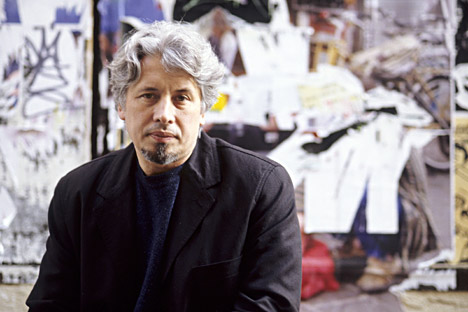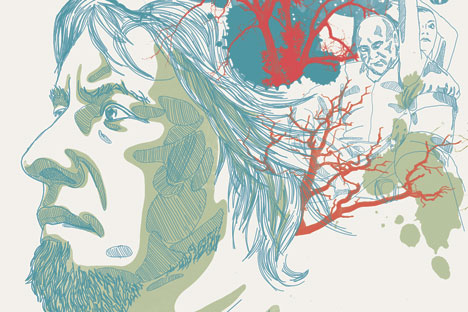The Blizzard: Chillingly dystopian in true Sorokin style

Vladimir Sorokin.
John Foley/Opale/Leemage/East News |
| The Blizzard. Vladimir Sorokin. Farrar, Straus and Giroux, December 2015 |
Perhaps it’s not surprising, given the weather, to find blizzards and snowstorms proliferating throughout Russian literature from Pushkin’s magic tales to Vladimir Sorokin’s mysterious 2010 novel, The Blizzard. Tolstoy’s short story of the same name, published in 1856 and based on his own experience, has clearly inspired the underlying premise of Sorokin’s novella: a man rides on a sledge through a plot-less snow storm with a fatalistic driver. They lose their way, tire out the horses and get side tracked by stream-of-consciousness reminiscences. The classic 19th-century setting is overlaid by Sorokin’s characteristically disturbing, dystopian vision. His protagonist, Doctor Garin, is carrying two bags of vital vaccines to a village infected by a mysterious epidemic that turns its victims into zombies.
Swiftian fantasy
In this atmospheric and perplexing work, soon to be available in Jamey Gambrell’s English translation, Vladimir Sorokin has pulled off another unlikely feat of generic fusion. His bizarre Ice trilogy (2002-2005) combined speculative fantasy with elements of ultra-violence and psychological thriller, into a sometimes-startling epic. The brutal 2006fable, Day of the Oprichnik, fused medieval legend with sci-fi to powerful satirical effect.
In The Blizzard Sorokin hijacks tropes from 19th-century Russian literature and, like some modern-day Frankenstein, grafts on ill-fitting limbs torn from other kinds of fiction: fairy tales and horror films, Tolkeinesque adventure and Swiftian fantasy. There are ceramic stoves and patchwork quilts, shot glasses and sour cabbage. There are echoes of Chekhov’s memoir from Sakhalin Island or Gogol’s Chichikov, crossing huge distances to buy up dead souls.
Into this familiar setting, Sorokin inserts his own brands of alternative technology: the distinctly Russian retro-future to which his characters are condemned contains genetically-modified creatures, including human beings, holographic radios, hi-tech hallucinogens, and living felt that can create a toasty tent in minutes; and yet his protagonists travel through an isolated wilderness by horse-drawn sledge, forever at the mercy of snow-filled ravines and broken runners, and in danger of freezing to death.
Gogol’s question
The disease that Garin is hurrying through the blizzard to prevent is later identified as the Bolivian plague or the Bolivian Black. It is left to the befuddled reader to surmise whether this rumored, zombifying illness represents contemporary propaganda, global apathy, drug addiction, all of these, or more. The hint of movie macabre stops short of full-blown apocalypse since the doomed sled never reaches the village. The meandering journey, powered by bird-sized horses, seems to echo of Gogol’s famous question: “Russia, winged troika, whither do you fly?”
Garin’s frustrated journey is as deliberately pointless as the mud crawling of Samuel Beckett’s Pim. There are Kafkaesque elements, with characters are so obviously metaphorical as to undermine the incongruous realism of Garin’s buttock-clenching sex with the miller’s wife (an echo of Schubert’s song cycle, Die schöne Müllerin). What else but allegory can possibly explain the Müllerin’s ridiculous, Lilliputian husband, the same height as a vodka bottle?
A Russian Ishiguro?
A more recent allegorical journey is conjured up when the travelers stumble over the drunken corpse of a Brobdingnagian, 20-foot-tall man lying in the snow. Kazuo Ishiguro’s The Buried Giant (2015) also involves a meandering journey through an oddly timeless, chilly, cod-historical world of log cabins and isolated villages, vague myths and garbled messages. Both authors are renowned for their earlier satirical brilliance; in both cases, the narratives become increasingly confused and dream-like, with the implication that there are profound depths lurking beneath their novels’ misty surfaces if only readers were clever enough to discern them.
Ishiguro’s buried giant appears to represent historical grievances, while Sorokin’s seems to stand for “good old Russian stupidity.” The image of the travelers trying to chop their way out of an enormous frozen nostril with an ax is one of those unforgettably grotesque Sorokinian moments.
From a disturbing encounter with the drug-dealing Vitaminders to a giant, ithyphallic snowman and marauding Chinese traders, there are details here that will please Sorokin’s fans and any reader who delights in imaginative absurdity. The snowman, whose tree-trunk penis seems “ready to pierce the surrounding world,” personifies the author’s gift for unpleasantly ominous imagery.
The Blizzard is, for all that, an outwardly gentler novel than Day of the Oprichnik; but at its heart it is a chilling vision of Russia’s fatally erratic journey. The anger of the earlier novel has frozen into numbness, the despair of the homeless alcoholic, lying down in a soft snowdrift with a lethal bottle of vodka.
Read more: The best contemporary young Russian writers
All rights reserved by Rossiyskaya Gazeta.
Subscribe
to our newsletter!
Get the week's best stories straight to your inbox

